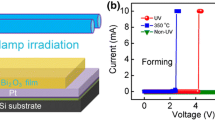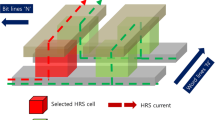Abstract
Resistive RAM (ReRAM) is a promising candidate for next-generation non-volatile memory; it uses resistive switching behavior by electrochemical migration of oxygen vacancies inside of transition metal oxides. Controlling the oxygen content of the resistive switching material is required during the film deposition step for resistive switching to occur. This study Pledemonstrated an electric field-assisted photochemical metal–organic deposition (EFAPMOD) method for controlling the oxygen content of amorphous phase TiOx thin film, a commonly used material for ReRAM. Various voltages (0, + 10, + 15, + 20 V) were applied using a specially designed photomask coated with a transparent conductive oxide film during the photochemical reaction by UV irradiation. As a result, the oxygen content at the film top surface could be controlled according to the magnitude of applied voltage. This effect was confirmed by X-ray photoelectron spectroscopy (XPS) and I–V characteristic measurement. The applied positive voltage induced high oxygen content at the top interface of the TiOx film, and the local region possessing high oxygen content (high resistance) induced a resistive switching event. The TiOx amorphous film formed by EFAPMOD + 20 V showed stable and consistent resistive switching behavior.





Similar content being viewed by others
References
A. Sawa, Resistive switching in transition metal oxides. Mater. Today 11(6), 28–36 (2008)
O. Auciello, J.F. Scott, R. Ramesh, The physics of ferroelectric memories. Phys. Today 51(7), 22–27 (1998)
S. Mathews, R. Ramesh, T. Venkatesan, J. Benedetto, Ferroelectric field effect transistor based on epitaxial perovskite heterostructures. Science 276(5310), 238–240 (1997)
J. Lee, S. Choi, C. Lee, Y. Kang, D. Kim, GeSbTe deposition for the PRAM application. Appl. Surf. Sci. 253(8), 3969–3976 (2007)
Z. Li, S. Zhang, Domain-wall dynamics driven by adiabatic spin-transfer torques. Phys. Rev. B 70(2), 024417 (2004)
R. Waser, R. Dittmann, G. Staikov, K. Szot, Redox-based resistive switching memories-nanoionic mechanisms, prospects, and challenges. Adv. Mater. 21(25–26), 2632–2663 (2009)
H.-S. Lee, S.G. Choi, H.-H. Park, M.J. Rozenberg, A new route to the Mott–Hubbard metal-insulator transition: strong correlations effects in Pr0.7Ca0.3MnO3. Sci. Rep. 3(1), 1704 (2013)
H.-S. Lee, H.-H. Park, M.J. Rozenberg, Manganite-based memristive heterojunction with tunable non-linear I–V characteristics. Nanoscale 7(15), 6444–6450 (2015)
H.-S. Lee, V.K. Sangwan, W.A.G. Rojas, H. Bergeron, H.Y. Jeong, J. Yuan, K. Su, M.C. Hersam, Dual-gated MoS2 memtransistor crossbar array. Adv. Funct. Mater. 30(45), 2003683 (2020)
J.J. Yang, M.D. Pickett, X. Li, D.A.A. Ohlberg, D.R. Stewart, R.S. Williams, Memrisitve switching mechanism for metal/oxide/metal nanodevices. Nat. Nanotechnol. 3, 429–433 (2008)
H.-T. Zhang, L. Guo, G. Stone, L. Zhang, Y.-X. Zheng, E. Freeman, D.W. Keefer, S. Chaudhuri, H. Paik, J.A. Moyer, Imprinting of local metallic states into VO2 with ultraviolet light. Adv. Funct. Mater. 26(36), 6612–6618 (2016)
Y. Park, D. Yoon, K. Fukutani, R. Stania, J. Son, Steep-slope threshold switch enabled by pulsed-laser-induced phase transformation. ACS Appl. Mater. Interfaces. 11(27), 24221–24229 (2019)
D.B. Strukov, G.S. Snider, D.R. Stewart, R.S. Williams, The missing memristor found. Nature 453, 80–83 (2008)
S.-E. Kim, J.-G. Lee, I.-Y. Choi, H.-E. Kim, H.-S. Lee, Resistive switching characteristic of Ce0.9Y0.1O2/TiO2 bi layer structure by photochemical metal organic deposition. J. Korean Ceram. Soc. 57(1), 73–79 (2020)
E. Carlos, R. Branquinho, R. Martins, A. Kiazadeh, E. Fortunato, Recent progress in solution-based metal oxide resistive switching devices. Adv. Mater. 33(7), 2004328 (2021)
Y. Wang, K.-M. Kang, M. Kim, H.-S. Lee, R. Waser, D. Wouters, R. Dittmann, J.J. Yang, H.-H. Park, Mott-transition-based RRAM. Mater. Today 28, 63–80 (2019)
Z. Wang, S. Joshi, S.E. Savel’ev, H. Jiang, R. Midya, P. Lin, M. Hu, N. Ge, J.P. Strachan, Z. Li, Q. Wu, M. Barnell, G.-L. Li, H.L. Xin, R.S. Williams, Q. Xia, J.J. Yang, Memristors with diffusive dynamics as synaptic emulators for neuromorphic computing. Nat. Mater. 16, 101–108 (2017)
S.H. Jo, T. Chang, I. Ebong, B.B. Bhadviya, P. Mazumder, W. Lu, Nanoscale memristor device as synapse in neuromorphic systems. Nano Lett. 10(4), 1297–1301 (2010)
S. Kim, C. Du, P. Sheridan, W. Ma, S. Choi, W.D. Lu, Experimental demonstration of a second-order memristor and its ability to biorealistically implement synaptic plasticity. Nano Lett. 15(3), 2203–2211 (2015)
M. Prezioso, F. Merrikh-Bayat, B.D. Hoskins, G.C. Adam, K.K. Likharev, D.B. Strukov, Training and operation of an integrated neuromorphic network based on metal-oxide memristors. Nature 521, 61–64 (2015)
J.J. Yang, D.B. Strukov, D.R. Stewart, Memristive devices for computing. Nat. Nanotechnol. 8, 13–24 (2013)
S. Tradel, G. Li, X. Zhang, R.H. Hill, Positive and negative lithography by photochemical metalorganic deposition from metal 2-ethylhexanoates. J. Photopolym Sci. Technol. 19, 467–475 (1998)
G.E. Buono-Core, G. Cabello, A.H. Klahn, A. Lucero, M.V. Nunez, B. Torrejon, C. Castillo, Growth and characterization of molybdenum oxide thin films prepared by photochemical metal-organic deposition (PMOD). Polyhedron 29, 1551–1554 (2010)
V. Jousseaume, J. Buckley, Y. Bernard, P. Gonon, C. Vallée, M. Mougenot, H. Feldis, S. Minoret, G. Chamiot-Maitral, A. Persico, A. Zenasni, M. Gely, J.P. Barnes, E. Martinez, H. Grampeix, C. Guedj, J.F. Nodin, B. De Salvo, Back-end-of-line integration approaches for resistive memories. 2009 IEEE Int. Interconnect Technology Conf. (Sapporo, Japan, 1–3 June 2009), pp. 41–43 (2009)
H.S.P. Wong, H.Y. Lee, S.M. Yu, Y.S. Chen, Y. Wu, P.S. Chen, B. Lee, F.T. Chen, M.J. Tsai, Metal-oxide RRAM. Proc. IEEE 100, 1951–1970 (2012)
S.-M. Kim, H.G. Moon, H.-S. Lee, Resistive switching characteristics of directly patterned Y-doped CeO2 by photochemical organic-metal deposition. Ceram. Int. 46(14), 22831–22836 (2020)
H.-H. Park, H.-S. Lee, H.-H. Park, X. Zhang, R.H. Hill, Fabrication of sub 50-nm direct-patterned Pb(Zr, Ti)O3 films by electron beam-induced metal-organic deposition. J. Electroceram. 24, 214–218 (2010)
H.-H. Park, X. Zhang, S.-W. Lee, K.-D. Kim, D.-G. Choi, J.-H. Choi, J. Lee, E.-S. Lee, H.-H. Park, R.H. Hill, J.-H. Jeong, Facile nanopatterning of zirconium dioxide films via direct ultraviolet-assisted nanoimprint lithography. J. Mater. Chem. 21, 657–662 (2011)
C. Binet, A. Badri, M. Boutonnet-Kizling, J.C. Lavalley, FTIR study of carbon monoxide adsorption on ceria: CO22− carbonite dianion adsorbed species. J. Chem. SoC. Faraday Trans. 90, 1023–1028 (1994)
H.H. Park, H.H. Park, R.H. Hill, Direct-patterning of SnO2 thin film by photochemical metal-organic deposition. Sens. Actuator A-Phys. 132, 429–433 (2006)
H.H. Park, S. Yoon, H.H. Park, R.H. Hill, Electrical properties of PZT thin films by photochemical deposition. Thin Solid Films 447, 699–673 (2004)
J.W. Lee, D.K. Kim, Carboxymethyl group activation of dextran cross-linked superparamagnetic iron oxide nanoparticles. J. Korean Ceram. Soc. 58(1), 106–115 (2021)
J. Zhao, M. Zhang, S. Wan, Z. Yang, C.S. Hwang, Highly flexible resistive switching memory based on the electronic switching mechanism in the Al/TiO2/Al/polyimide structure. ACS Appl. Mater. Interfaces 10(2), 1828–1835 (2018)
G. Rajender, J. Kumar, P.K. Giri, Interfacial charge transfer in oxygen deficient TiO2-graphene quantum dot hybrid and its influence on the enhanced visible light photocatalysis. Appl. Catal. B. 224, 960–972 (2018)
D.-H. Hop, R.B.K. Chung, Y.-W. Heo, J.-J. Kim, J.-H. Lee, Oxygen nonstoichiometry and electrical properties of La2−xSrxNiO4+δ (0 ≤ x ≤ 05). J. Korean Ceram. Soc. 57(4), 416–422 (2020)
Y. Park, H. Sim, M. Jo, G.-Y. Kim, D. Yoon, H. Han, Y. Kim, K. Song, D. Lee, S.-Y. Choi, Directional ionic transport across the oxide interface enables low-temperature epitaxy of rutile TiO2. Nat. Commun. 11(1), 1–10 (2020)
F.-C. Chiu, A review on conduction mechanisms in dielectric films. Adv. Mater. Sci. Eng. 2014, 578168 (2014)
Acknowledgements
This work was supported by the National Research Foundation of Korea(NRF) Grant funded by the Korea government(MSIT) (2019R1F1A1059637) and the Ministry of Trade, Industry and Energy (MOTIE, Korea) under the Industrial Strategic Technology Development Program. No. 10068075, 'Development of Mott-transition-based forming-less non-volatile resistive switching memory and array'. Device fabrication and analysis were supported by 2018 Research Grant (PoINT) from Kangwon National University.
Author information
Authors and Affiliations
Corresponding author
Rights and permissions
About this article
Cite this article
Kim, SE., Lee, HS. An electric field-assisted photochemical metal–organic deposition allowing control of oxygen content for resistive switching in directly patterned TiOx films. J. Korean Ceram. Soc. 58, 672–678 (2021). https://doi.org/10.1007/s43207-021-00139-z
Received:
Revised:
Accepted:
Published:
Issue Date:
DOI: https://doi.org/10.1007/s43207-021-00139-z




